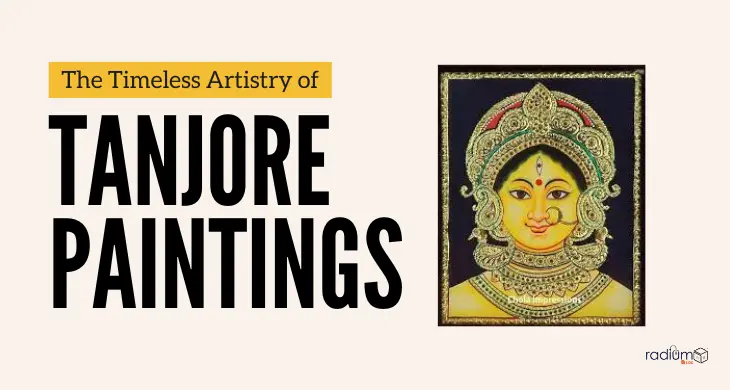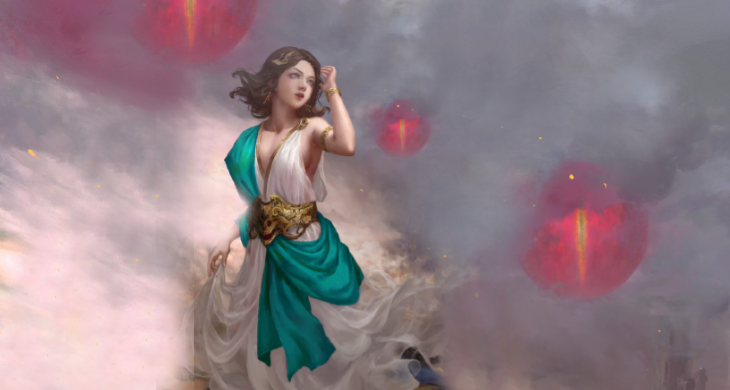In the vibrant tapestry of Indian artistry, Tanjore paintings stand as a testament to centuries-old craftsmanship and cultural opulence. “Golden Strokes: The Timeless Artistry of Tanjore Paintings” embarks on a journey through the resplendent world of these treasured South Indian artworks, each stroke resonating with heritage, mythology, and an unparalleled richness.
With hues that shimmer like precious gems and embellishments that gleam in gold, Tanjore paintings encapsulate a tradition steeped in tradition and devotion. From intricate mythological depictions to ornate religious motifs, these artworks are not mere visual marvels; they are windows to a bygone era, each stroke a tale echoing the artistic legacy of Thanjavur, its birthplace.
Join us as we unveil the allure of these captivating masterpieces, exploring the techniques, cultural significance, and enduring allure of Tanjore paintings. Step into a realm where vibrant colors dance alongside divine narratives, and golden strokes immortalize a heritage that transcends time itself.
Origins and History:
The origins and history of Tanjore paintings trace back to the cultural hub of Thanjavur (formerly known as Tanjore) in Tamil Nadu, India. These paintings emerged during the Maratha rule in the 16th century and flourished under the patronage of the Nayak and Maratha rulers of the region.
Historical Roots:
- Maratha Influence: Tanjore paintings found their genesis during the reign of the Marathas in Thanjavur, where they evolved as a distinguished form of art patronized by the Maratha rulers.
- Artisanal Heritage: The art form draws from a fusion of diverse cultural influences, blending the artistic finesse of local artisans with elements from Nayak and Maratha cultures.
Evolution and Development:
- Religious Patronage: Initially, Tanjore paintings served as adornments in temples and royal courts, depicting divine entities, especially Hindu deities, to convey religious narratives and devotional fervor.
- Iconic Characteristics: Over time, Tanjore paintings became renowned for their distinctive features like the use of rich colors, gold leaf embellishments, elaborate ornamentation, and intricate detailing.
Cultural Significance:
- Spiritual Reflection: Tanjore paintings reflect the rich cultural heritage and spiritual fervor of South India, depicting mythological stories and religious themes, often portraying gods and goddesses with reverence and divinity.
- Artisanal Legacy: The craftsmanship involved in Tanjore paintings reflects a heritage passed down through generations, embodying intricate techniques and artistic sensibilities unique to the region.
Enduring Legacy:
- Continued Relevance: Despite the passage of time, Tanjore paintings retain their cultural relevance and aesthetic allure, captivating art enthusiasts, historians, and connoisseurs worldwide with their timeless beauty and artistic intricacy.
The historical roots of Tanjore paintings reveal an art form deeply entrenched in cultural heritage, religious devotion, and artisanal craftsmanship, embodying the essence of South Indian artistic legacy that continues to captivate audiences across generations.
Techniques and Materials:
The creation of Tanjore paintings involves intricate techniques and specific materials, contributing to their distinctive appearance and cultural significance.
Materials Used:
- Wooden Panels: Traditional Tanjore paintings are crafted on wooden panels, often made of jackfruit or teak wood, providing a sturdy base for the artwork.
- Canvas Preparation: The wooden surface is typically coated with a mixture of limestone and a binding medium like tamarind seed glue, creating a smooth base for painting.
- Vibrant Pigments: Artists use vivid and bright colors made from natural mineral and vegetable dyes, ensuring a striking visual appeal.
Techniques Employed:
- Gold Leaf Embellishment: One of the most iconic elements is the use of gold foil or leaf (called ‘varak’) that adorns the paintings. The gold leaf is meticulously applied using an adhesive to specific areas, enhancing the opulence and divinity of the artwork.
- Relief Work: To create a three-dimensional effect, artists use stucco or chalk powder mixed with glue, shaping it into raised structures to delineate specific elements in the painting, such as jewelry or garments.
- Intricate Detailing: Fine brushwork is employed to depict intricate patterns, jewelry, facial expressions, and clothing with utmost precision and attention to detail.
Additional Embellishments:
- Semi-Precious Stones: Some Tanjore paintings incorporate semi-precious or glass stones, known as ‘kundan,’ to embellish jewelry or add sparkle to specific areas.
- Glass Beads: Artists sometimes embed glass beads to create a textured effect or enhance the visual appeal of certain elements, adding depth and dimensionality to the artwork.
Craftsmanship and Preservation:
- The craftsmanship involved in Tanjore paintings requires patience, skill, and a meticulous approach to apply the gold leaf, colors, relief work, and other embellishments with precision.
- Preservation of these paintings involves protecting them from environmental factors like humidity and direct sunlight to ensure their longevity and maintain their vividness and richness.
The combination of specific materials, intricate techniques, and embellishments like gold leaf and semi-precious stones contributes to the unique charm and opulence of Tanjore paintings, showcasing the exquisite craftsmanship and artistic finesse of this revered art form.
Themes and Depictions:
Tanjore paintings primarily revolve around specific themes and depictions, each narrating stories rooted in Hindu mythology, spirituality, and cultural traditions. These themes and depictions play a pivotal role in defining the essence and significance of Tanjore paintings.
Hindu Deities and Mythological Tales:
- Gods and Goddesses: Tanjore paintings prominently feature Hindu deities like Lord Krishna, Lord Shiva, Goddess Lakshmi, Saraswati, and others, portrayed with divine attributes and reverence.
- Mythological Narratives: Scenes from Hindu epics such as Ramayana, Mahabharata, and Bhagavad Gita are depicted with intricate details, conveying moral stories, heroic deeds, and spiritual teachings.
Iconography and Symbolism:
- Mudras and Poses: Deities are often portrayed in specific mudras (hand gestures) and poses known as ‘asanas,’ each holding symbolic significance representing their divine attributes or actions.
- Divine Ornaments: Elaborate jewelry and divine ornaments embellish the deities, symbolizing their celestial status and adding to the opulence of the artwork.
Spiritual and Devotional Themes:
- Temples and Rituals: Tanjore paintings might portray sacred temple scenes, depicting rituals, festivals, or architectural marvels of revered temples from South India.
- Devotional Expressions: Emotions of devotion, love, and reverence are vividly depicted through facial expressions and postures, capturing the essence of bhakti (devotion) in the artwork.
Cultural and Traditional Context:
- Royal Patronage: Some Tanjore paintings showcase the patronage of royal courts, with portraits of rulers or nobility depicted alongside religious themes.
- Cultural Festivities: Scenes of cultural celebrations, processions, or significant cultural events are sometimes depicted, reflecting the vibrancy of South Indian traditions.
Divine Aesthetics and Grandeur:
- Richness and Opulence: The use of gold leaf, vibrant colors, and intricate detailing imparts a sense of grandeur and divine splendor, elevating the aesthetic appeal of the paintings.
Tanjore paintings act as visual narratives, weaving together spirituality, mythology, cultural richness, and artistic beauty. They serve as windows to an ancient world, offering a glimpse into the divine realms and cultural heritage of South India, resonating with spiritual depth and aesthetic allure.
Cultural Significance:
The cultural significance of Tanjore paintings transcends their artistic beauty, weaving a tapestry deeply intertwined with heritage, spirituality, and societal traditions.
Preservation of Religious Narratives:
- Tanjore paintings are integral in preserving and perpetuating Hindu religious narratives, immortalizing the stories from ancient scriptures like the Ramayana, Mahabharata, and Puranas through vibrant visuals.
Expression of Devotion and Spirituality:
- These paintings embody the devoutness and spiritual fervor of South Indian culture, depicting gods and goddesses with divine grace and reverence, serving as objects of veneration and spiritual inspiration.
Cultural Heritage and Tradition:
- Tanjore paintings encapsulate the cultural ethos of South India, reflecting the region’s artistic legacy, craftsmanship, and the fusion of local traditions with influences from different dynasties and cultures.
Royal Patronage and Artistic Patronage:
- Historically, Tanjore paintings received royal patronage, reflecting their association with the aristocracy and the affluent, underscoring their significance as symbols of prestige and cultural refinement.
Symbol of Artistic Mastery:
- The meticulous techniques, use of gold leaf, vibrant colors, and intricate detailing stand as testaments to the exceptional craftsmanship and artistic finesse prevalent in South Indian artistry.
Community and Ritual Significance:
- Tanjore paintings often adorned temples and households, enriching the cultural ambiance and acting as objects of reverence during religious ceremonies and rituals.
Cultural Continuity and Admiration:
- Through generations, Tanjore paintings have maintained their allure, fostering an appreciation for traditional art forms and serving as cherished artifacts valued for their cultural heritage.
The cultural significance of Tanjore paintings extends beyond aesthetics, symbolizing a confluence of art, spirituality, and heritage deeply embedded in the cultural fabric of South India, ensuring the preservation of cultural narratives and artistic traditions for generations to come.
Preservation and Contemporary Adaptations:
Preserving Tanjore paintings is crucial to maintain their historical and artistic value, given their delicate nature and cultural significance. Additionally, contemporary adaptations have emerged, blending traditional techniques with modern sensibilities.
Preservation Efforts:
- Climate Control: Preservation involves maintaining stable environmental conditions, including temperature and humidity control, to prevent deterioration of the paintings.
- Conservation Techniques: Experts employ specialized conservation techniques to restore and preserve aging or damaged Tanjore paintings, ensuring their longevity.
- Education and Awareness: Initiatives promoting awareness about proper handling, storage, and conservation practices among collectors, institutions, and artists are essential for preserving these artworks.
Contemporary Adaptations:
- Modern Subjects and Themes: Some artists explore modern subjects or themes while retaining traditional Tanjore painting techniques, offering contemporary narratives.
- Experimentation with Materials: Contemporary adaptations involve experimenting with different materials, colors, or textures while adhering to the essence of Tanjore paintings.
- Fusion with Other Art Forms: Artists blend Tanjore painting techniques with other artistic forms, such as mixed media or digital art, creating innovative expressions.
Revival and Revitalization Efforts:
- Artistic Revival: Efforts to revive and promote Tanjore paintings involve workshops, educational programs, and platforms that encourage younger generations to learn and practice this art form.
- Collaborations and Exhibitions: Collaborations between traditional artists and contemporary platforms or art institutions showcase the adaptability and relevance of Tanjore paintings in the modern art scene.
Digital Preservation and Documentation:
- Digital Archiving: Creating digital archives and documentation of Tanjore paintings helps in preserving their essence, allowing wider access for research, education, and appreciation.
Ethical Considerations:
- As Tanjore paintings gain global recognition, ethical considerations about cultural appropriation and authenticity are crucial, emphasizing the importance of respecting the traditional art form’s roots and cultural significance.
Appreciation and Collectibility:
Appreciation and collectibility of Tanjore paintings stem from their cultural significance, artistic allure, and historical value, attracting enthusiasts, collectors, and connoisseurs alike.
Cultural Appreciation:
- Enthusiasts appreciate Tanjore paintings for their deep-rooted connection to South Indian culture, acknowledging their role in preserving religious narratives and artistic heritage.
Aesthetic Appeal and Artistry:
- Collectors are drawn to the exquisite craftsmanship, vibrant colors, intricate detailing, and use of gold leaf that define the opulent beauty and artistic finesse of Tanjore paintings.
Investment and Rarity:
- Collectors often perceive Tanjore paintings as valuable investments due to their rarity, historical significance, and the skill required in creating these intricate artworks.
Spiritual and Decorative Significance:
- Beyond their artistic value, these paintings hold spiritual significance for many individuals, often adorning homes, temples, or spaces associated with religious observances, contributing to their decorative appeal.
Art Market and Recognition:
- The recognition and acclaim garnered by Tanjore paintings in the art market, both nationally and internationally, contribute to their collectibility and increased demand among art enthusiasts.
Cultural Legacy and Historical Significance:
- Tanjore paintings’ connection to historical narratives, their portrayal of iconic deities and mythological tales, and their representation of centuries-old traditions enhance their desirability as culturally significant artifacts.
Artistic Expression and Mastery:
- Collectors appreciate the mastery and skill exhibited by artists in crafting these paintings, recognizing the technical expertise and dedication required to create such intricate and visually captivating artworks.
Frequently Asked Questions:
1. What are Tanjore paintings?
Tanjore paintings are a traditional art form from South India, particularly Thanjavur, known for their rich colors, gold leaf embellishments, and depictions of Hindu deities and mythological themes.
2. What materials are used in creating Tanjore paintings?
Traditional Tanjore paintings are crafted on wooden panels using vibrant colors, gold foil or leaf, semi-precious stones, and at times, embedded glass beads for embellishments.
3. What themes do Tanjore paintings typically depict?
These paintings often portray Hindu gods and goddesses like Lord Krishna, Goddess Lakshmi, and scenes from epics like Ramayana and Mahabharata, reflecting religious and mythological narratives.
4. How do Tanjore paintings differ from other Indian art forms?
Tanjore paintings stand out for their use of gold leaf, intricate detailing, and three-dimensional effects created by the use of embellishments, distinguishing them from other Indian art forms.
5. Are Tanjore paintings still relevant today?
Yes, Tanjore paintings continue to be appreciated for their cultural significance and aesthetic appeal. They adorn homes, temples, and art collections, transcending time with their enduring beauty.
Conclusion:
As we draw the curtains on this odyssey, we are left spellbound by the vibrancy of hues, the intricate details, and the shimmering opulence that defines Tanjore paintings. These masterpieces aren’t just works of art; they are conduits that transport us across epochs, connecting us to a heritage steeped in reverence and artistic finesse.
The allure of Tanjore paintings lies not only in their aesthetic magnificence but also in the stories they narrate—the tales of gods and goddesses, the retelling of epics, and the cultural fabric that binds generations together. Each stroke, each gilded embellishment, echoes the devotion and craftsmanship of artisans who breathed life into these creations.
Yet, as we admire their timelessness, we also acknowledge their relevance in the contemporary world—a testament to an artistic tradition that continues to captivate hearts and minds, transcending geographical boundaries.




